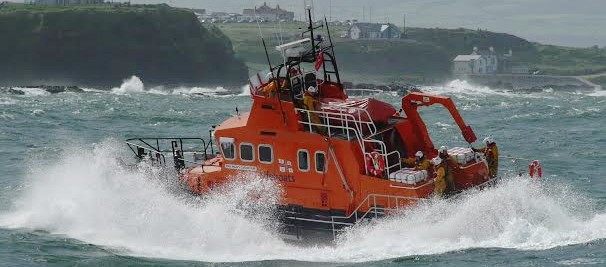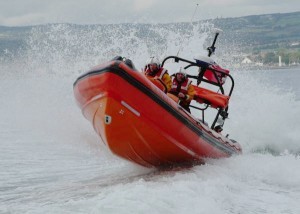 Last year was one of busiest here in the 190-year history of the RNLI (Royal National Lifeboat Institution).
Last year was one of busiest here in the 190-year history of the RNLI (Royal National Lifeboat Institution).
The seas around our coastline are some of the most treacherous in these islands.
Warm southern waters and cold northern currents clashing along 400 miles of coast and create dangerous waves and whirlpools between here and Scotland – just 13 miles away at its narrowest point.
Last year, 292 people owed their lives to the volunteers of the RNLI from the North and Donegal.
Supporters here help raise some of the £140 million a year needed to run the charity.
It’s unofficial song, “Home from the Sea,” was written by Derry singer-composer Phil Coulter who lost a family member in a drowning tragedy.
When a ‘shout’ is signalled, crew rush to their lifeboat station, trained and ready for action. Most are at sea within 10 minutes.
Last year, crews launched 326 times.
On 10 occasions they were called to rescue animals including four dogs, two sheep, a cow, two whales and a dolphin.
Among the volunteers are a surgeon, publican, plumber and police officer. More than 30 are women.
Philip has been coxswain at Donaghadee for 15 years. The boat launched 26 times last year.
He said: “It was a sense of adventure that persuaded me to get involved but I’ve come to love the organisation and hope to be part of it for as long as I can make a contribution. Once we pulled a man from the water believing he had drowned. The crew delivered casualty care training and saved his life.”
Newcastle: The North’s oldest lifeboat station is at Newcastle. Established in1825, its crews have won 30 RNLI medals for gallantry. The most famous shout was in 1942. Seven crew received medals after rescuing 14 people from the Sandhill which struck a mine off the English coast and was carried to Ireland in a storm. The station operates inshore and all-weather lifeboats.
Bangor: Lifeboats were based at Groomsport in 1858 and Carrickfergus in 1896 but the RNLI moved to Bangor in 1965. Helmsman Brian Meharg was awarded an MBE and crew members received the Freedom of North Down Borough in 2010. The station operates an inshore lifeboat.
Portrush: The first lifeboat arrived in 1860 and three crew members lost their lives when it capsized off Portballintrae in 1889. Fourteen people were saved from the Argo Delos during a storm off the coast of Donegal in 1960. Coxswains Sam Cunningham and Robert McMullan were awarded RNLI medals for bravery. The station operates inshore and all weather lifeboats.
Portaferry: A lifeboat was stationed at Ballywalter in 1865, at Cloughey in 1884 and Portavogie in 1965 but the RNLI moved to Portaferry in 1981. Helmsman Desmond Rodgers received an RNLI medal for bravery after the rescue of crew from the yacht Frieda which ran aground in Strangford Lough in 1982. Motorcycle aces Joey and Robert Dunlop were among 12 rescued from the Tornamona, which ran aground in 1985. The station’s inshore lifeboat was presented by the BBC children’s programme in 2010.
Arranmore: The first lifeboat arrived in 1883. RNLI bravery medals were awarded and a medal presented to the crew by Queen Wilimena of the Netherlands after the rescue of crew from the Dutch steamer Stolwick which ran aground in gales in 1940. A new lifeboat station was opened by singer Daniel O’Donnell in 1997. It operates an all-weather lifeboat.
Donaghadee: Local people financed the first lifeboat in 1910. Coxswain Samuel Nelson received an RNLI bravery medal for his role in the rescue of seven people from The Coastville and nine from The Hope Star in1940. An RNLI bravery medal and a British Empire Medal were awarded to coxswain Hugh Nelson for saving 31 from the Princess Victoria in 1953. Coxswain Billy Lennon received a British Empire Medal on retirement in 1991. The station is home to all weather lifeboat.
Bundoran: A lifeboat service was established in 1972 after a drowning tragedy that could have been prevented by a suitable vessel and it responded to the Mountbatten bombing in 1979. A storm destroyed the boathouse and washed the lifeboat out to sea in 1988. The RNLI was invited to take over the service in 1991. The station operates an inshore lifeboat.
Kilkeel: A lifeboat was first stationed in the town in 1986, at the request of the local Chamber of Commerce, and it saw action within four days. The crew rescued three from a burning fishing vessel Orion in 2005. The station operates an inshore lifeboat and two of the crew are women.
Lough Swilly: The lifeboat arrived on station in Buncrana in 1988. The crew’s most challenging shout was in 2007 when six people on the fishing vessel Mary Ellen were saved. A tow rope broke twice in story seas during the lengthy rescue operation. The station operates inshore and all-weather lifeboats.
Red Bay: The first lifeboat arrived in 1972 and the station enjoys the support of singers Frances and Mary Black who lost a family member in a drowning tragedy. It is regularly involved in rescue operations off the Scottish coast and the crew rescued people from their homes when Ballycastle and Cushendall were flooded in 1990. The station operates an inshore lifeboat.
Larne: The first lifeboat was stationed in the busy port in 1994. It saved the six crew of the Scottish trawler Silvery Sea from rocks near the Maidens in a storm in 1996. Sadly the fishing boat and crew were lost the following year off the coast of Denmark. Today Larne operates inshore and all-weather lifeboats.
Enniskillen: Enniskillen is Ulster’s newest lifeboat station opening in 2001. Last year it was the busiest with 56 launches on lough Erne. These included rescuing a tourist cruiser from the rocks on a stormy night and responding to a light aircraft which ditched in the lake. It operates two inshore lifeboats and two rescue jet skis at Lough Erne Yacht Club and Carrybridge.
Tags:





